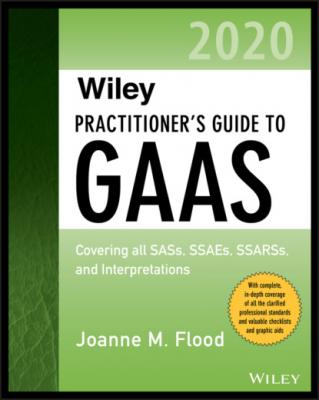Wiley Practitioner's Guide to GAAS 2020. Joanne M. Flood
Читать онлайн.| Название | Wiley Practitioner's Guide to GAAS 2020 |
|---|---|
| Автор произведения | Joanne M. Flood |
| Жанр | Бухучет, налогообложение, аудит |
| Серия | |
| Издательство | Бухучет, налогообложение, аудит |
| Год выпуска | 0 |
| isbn | 9781119596035 |
The effect of significant accounting policies in controversial or emerging areas (or those unique to an industry, particularly when there is a lack of authoritative guidance or consensus).
The effect of the timing of transactions in relation to the period in which they are recorded.
Accounting Estimates
For items for which estimates are significant, issues discussed in AU-C 540, Auditing Accounting Estimates, Including Fair Value Accounting Estimates and Related Disclosures, include, for example:
Management’s identification of accounting estimates
Management’s process for making accounting estimates
Risks of material misstatement
Indicators of possible management bias
Financial Statement Disclosures
The issues involved, and related judgments made, in formulating particularly sensitive financial statement disclosures (for example, disclosures related to revenue recognition, going concern, subsequent events, and contingency issues)
The overall neutrality, consistency, and clarity of the disclosures in the financial statements
Related Matters
The potential effect on the financial statements of significant risks and exposures, and uncertainties, such as pending litigation, that are disclosed in the financial statements.
The extent to which the financial statements are affected by unusual transactions, including nonrecurring amounts recognized during the period, and the extent to which such transactions are separately disclosed in the financial statements.
The factors affecting asset and liability carrying values, including the entity’s bases for determining useful lives assigned to tangible and intangible assets. The communication may explain how factors affecting carrying values were selected and how alternative selections would have affected the financial statements.
The selective correction of misstatements—for example, correcting misstatements with the effect of increasing reported earnings, but not those that have the effect of decreasing reported earnings.
Other AU-C Sections
Requirements to communicate with those charged with governance are included in other AU-C sections, and readers should refer to those sections in this book: AU-C Sections 210, 240, 250, 265, 550, 560, 570, 600, 705, 706, 720, 730, 930, and 935.
8 AU-C 265 Communicating Internal Control Related Matters Identified in an Audit
Determining Whether Deficiencies in Internal Control Have Been Identified
Indicators of Material Weakness
Communication of Internal Control Related Matters
SCOPE
The previous chapter, on AU-260, addressed the auditor’s responsibility to communicate with those charged with governance regarding the audit. AU-C 265 addresses the auditor’s responsibilities regarding communicating to management and those charged with governance identified deficiencies in internal control. (AU-C 265.01)
If the auditor is engaged to perform an audit of internal control over financial reporting that is integrated with the audit of financial statements, the auditor should apply the guidance in AR-C 940. (AU-C 265.04)
DEFINITIONS OF TERMS
Source: AU-C 265.07. For definitions related to this standard, see Appendix A, “Definitions of Terms”: Deficiency in internal control, Material weakness, Significant deficiency.
OBJECTIVE OF AU-C SECTION 265
The objective of the auditor is to appropriately communicate to those charged with governance and management deficiencies in internal control that the auditor has identified during the audit and that, in the auditor’s professional judgment, are of sufficient importance to merit their respective attentions.
(AU-C Section 265.06)
REQUIREMENTS
Determining Whether Deficiencies in Internal Control Have Been Identified
The auditors must determine whether, on the basis of the audit work performed, they have identified one or more deficiencies in internal control. (AU-C 265.08)
Determination of Deficiency Severity
The auditor must evaluate identified control deficiencies to determine whether they are— individually or in the aggregate—significant deficiencies or material weaknesses. (See “Definitions of Terms” section earlier in this chapter for definitions of those terms.) (AU-C 265.09) When evaluating the severity of control deficiencies, the auditor should consider both the possibility and the magnitude of the misstatement that could result from the deficiency.
The magnitude of a misstatement can be impacted by such factors as the amount or transaction
